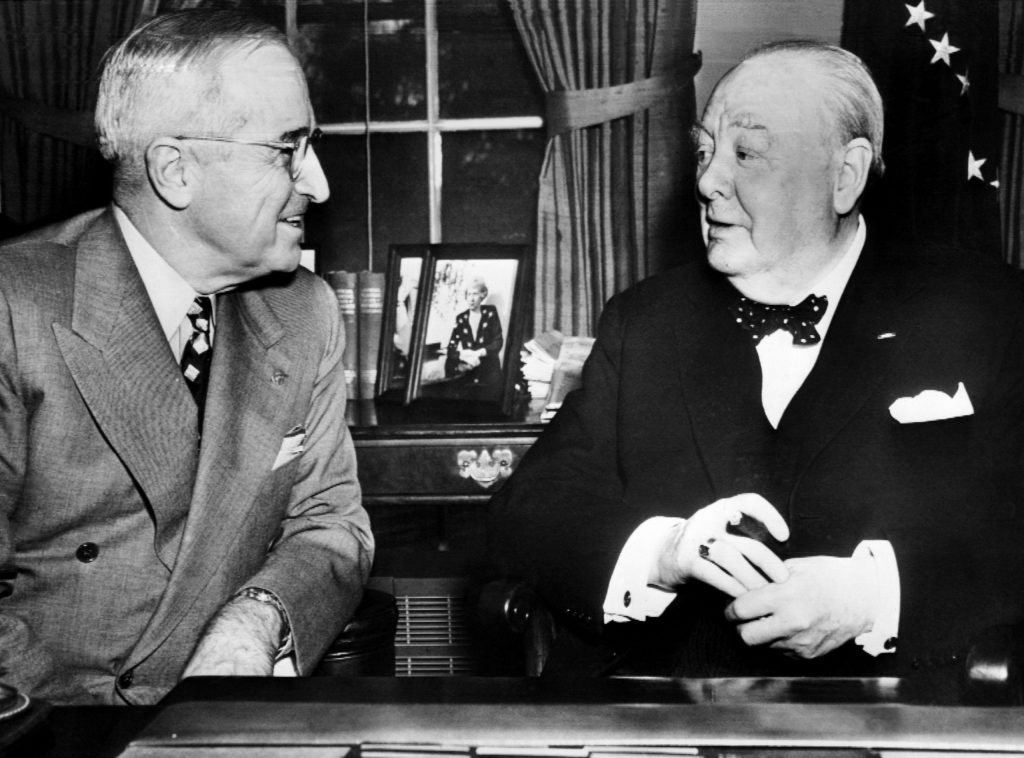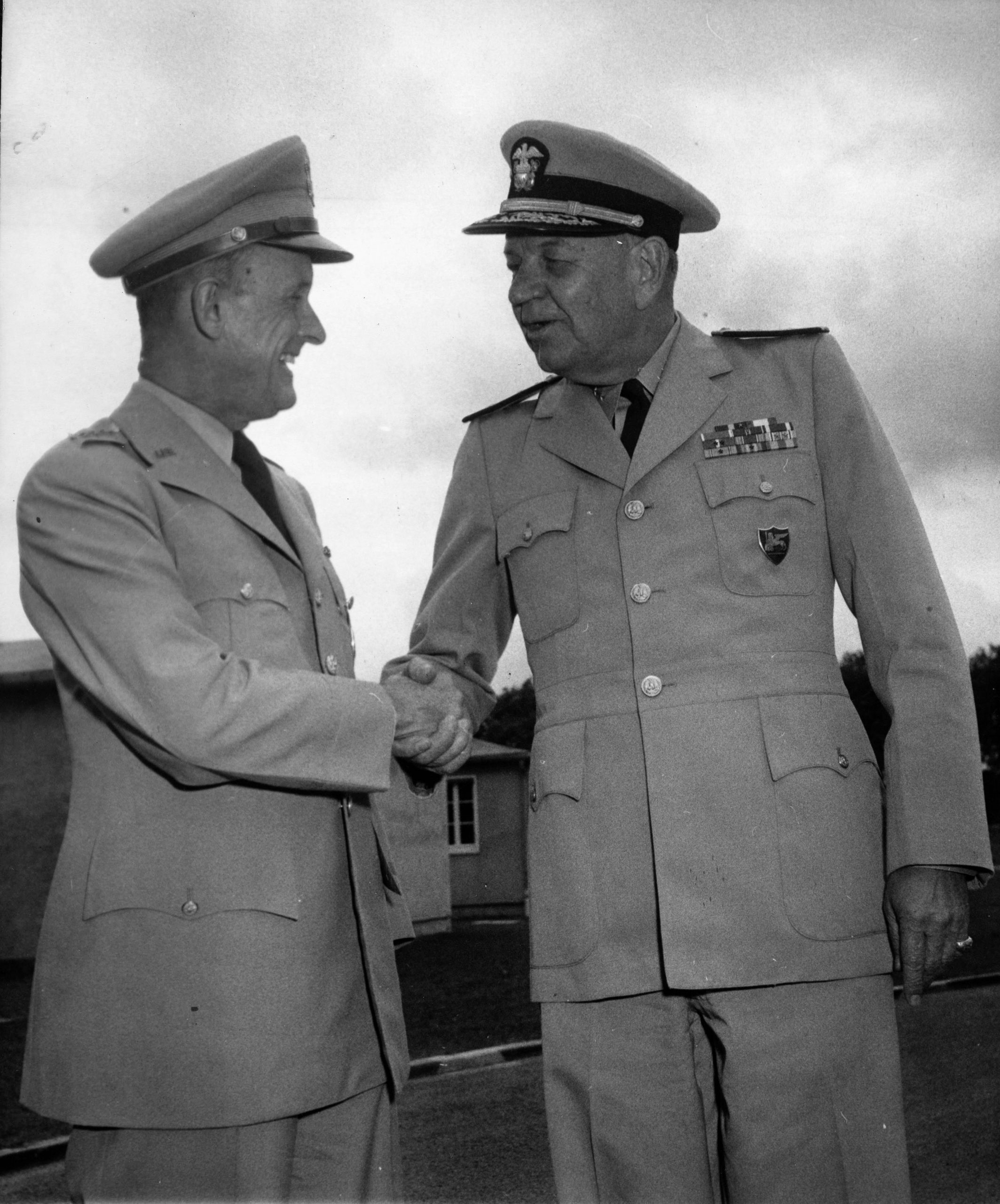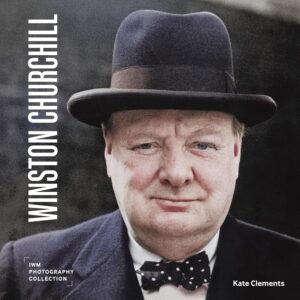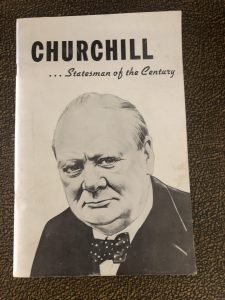Finest Hour 186
Churchill and Truman

Churchill and Truman meet in the White House during Churchill's visit to Washington in 1952.
March 11, 2020
Finest Hour 186, Fourth Quarter 2019
Page 18
By Alan P. Dobson
Alan P. Dobson teaches at Swansea University and is editor of International History Review. He is co-author with Steve Marsh of US Foreign Policy since 1945 (2007).
Winston Churchill presided over Britain’s finest hour in 1940 and celebrated victory over the Axis Powers in 1945, but was then unceremoniously turned out of office by the British electorate. In opposition, he was only able to watch as victory gave way to Cold War, and his much-vaunted Special Relationship with the US declined in intimacy and substance. Thus, when opportunity beckoned with success in the General Election in the autumn of 1951, he determined to inject new purpose into British foreign policy and was quick to tend to the “intimate relationship with the United States, which had been a keynote of his policy in the war….” For Churchill that meant above all establishing a close relationship with President Harry S. Truman in order to emulate the successful and rewarding personal relationship that he had experienced with Roosevelt.
Churchill and Truman had little in common by background; Churchill born into a historic and privileged family, Truman born in a simple farmhouse, and their life experiences were also so different, culminating in Churchill being hailed as the greatest man of his age and Truman as the accidental president. Even so, in 1946 when Churchill travelled with the President to Fulton Missouri for his famous Iron Curtain Speech aboard FDR’s old armored railroad car the Ferdinand Magellan, they got on well and established a firm friendship. That was despite Churchill losing over $200 playing poker until the early hours with Truman and his card-playing cronies. Truman and Churchill were now on first-name terms, though Truman confessed to finding that difficult at first because of Churchill’s standing. Sometime later, in July 1948, Truman in the throes of his re-election campaign wrote to Churchill:
I was deeply touched by your good letter of June 7. I am going through a terrible political “trial by fire.” Too bad it must happen at this time. May God bless and protect you.
Washington, 1952
By 1951 Churchill felt that Britain’s power, prestige, and status had all slipped badly—and unwarrantedly so under the Attlee government. He was determined to reverse that trend as much as he could. But the question was: how? Supreme confidence in his own skills as statesman and diplomat provided the answer: a summit meeting with the President. Accordingly, on 30 December 1951, Churchill set sail for the US on the Queen Mary. Importantly, both sides looked to the meeting to improve the tone of their relations, but there were difficult and intractable problems in their relations, including Britain’s economic problems, which dramatised the gap between its resources and commitments and its dependence on the USA; diverging Cold War strategies; and a deterioration in the tone and quality of the relationship itself. Paul Nitze, Director of the US State Department Policy Planning Staff, observed on 29 November 1951 that the Special Relationship “has not worked well since Mr. [Ernest] Bevin became ill. It has not worked at all well with Mr. [Herbert] Morrison [Bevin’s successor as British Foreign Secretary].” Churchill believed that much could be accomplished on seemingly intractable issues of substance if only there were more goodwill and bonhomie on each side. He would go to America “to re-establish relations, not to transact business.” This was a rhetorical flourish, but there was substance to it as well.
Churchill was primarily concerned that the tone of the special relationship be improved. Only then, he reasoned, could the two allies resolve or learn to live more amicably with each other’s differences. That tone was a central issue is indisputable. On 10 December Churchill wrote to Truman that “My object and wish is that we should reach a good understanding of each other’s point of view over the whole field so that we can work together easily and intimately at the different levels as we used to.” Truman responded by saying that it was his “sincere belief that talks of this sort reinforce the close ties that link our two countries, the maintenance of which is of vital importance.”
This was good news for Churchill, but Truman was not so keen on freewheeling talks as the Prime Minister, from whom there were awkward difficulties in extracting an agenda. Churchill wanted to keep things free to flow as they will, or rather, as he and his persuasive rhetoric would direct them. This, the Americans were unlikely to allow. When Under Secretary of State James Webb cautioned Truman that Churchill might try to resurrect the personal style he had had with Roosevelt, Truman said, “this was not his [own] desire; that he wished his advisers present; that he wished an agenda made up for the meetings….” A whiff of these problems had in fact already reached the British Embassy, and at the end of November Ambassador Sir Robert Makins wrote from Washington to Foreign Secretary Eden:
I want to make a special point. Mr. Truman is not Mr. Roosevelt, and his method of working is different. He takes advice. The procedure for these talks is likely to be formal with morning and afternoon meetings at the White House with a fixed agenda, Mr. Truman being accompanied by his principal Ministers and advisers, specific questions being remitted for discussion and report by groups of advisers.
Once the agenda and schedule had been worked out, Truman wrote to Churchill on 28 December that he was looking forward “with particular pleasure” to dinner on the presidential yacht, the Williamsburg, on the evening of 5 January because it would be “an opportunity for a good informal talk.” But, such informality was to be the exception, not the rule. It did not look as if Churchill would be able to conduct his favourite long, late-night disquisitions on the state of the world and how closely co-ordinated Anglo-American action could solve its problems. Nevertheless, on the American side there was a genuine commitment to improving the tone, albeit by a rather different modus operandi. Speaking of developments just prior to Churchill’s arrival, Secretary of State Dean Acheson recorded later that
President Truman approved some general conclusions we had reached about the visit. Of first importance would be the tone and atmosphere of the meetings. Mr. Churchill should return home in a good mood. This did not require material concessions or changes in U.S. policy, but long, intimate, and frank discussions conducted with respect and good will.
It is true that there was widespread determination among the Americans that there would be no resurrection of the wartime combined boards and above “all, we do not want to reconstruct the Roosevelt-Churchill relationship of the last war.” The Americans did not want to appear to be discriminating against their other allies, in particular the French, by re-forming a formal special relationship with Britain, and they did not want to create any machinery that would constrain American actions or provide the British with an effective veto over them. But they recognised the existence of a de facto special relationship, wanted to work closely with the British and retain access to British world-wide bases, and recognised the need for improving the quality and increasing the frequency of consultative talks in order to align their tactics and strategies more closely.
SACLANT
Ironically the most contentious and difficult issue at the conference for Churchill was the fact the previous government had agreed to an American, US Admiral William Morrow Fechteler, being designated as NATO Supreme Allied Commander Atlantic (SACLANT). Churchill was dogged in his attempt to over-turn that agreement, which would test his growing friendship with Truman and jeopardise his intention of improving Anglo-American relations. Churchill felt that for the great Royal Navy not to command the eastern reaches of the Atlantic—Britain’s naval backyard—was just too humiliating.

In fact the issue of SACLANT was settled to the satisfaction of all the British delegation except Churchill at the very start of the conference. At an Anglo-American Chiefs of Staff meeting on 6 January, British First Sea Lord Admiral Sir Rhoderick R. McGrigor argued as instructed by Churchill for the division of the Atlantic between the Royal and US navies, which effectively meant side-lining NATO. General of the Army Omar Bradley, the Chairman of the Joint Chiefs of Staff for the United States, responded that—while he was aware of British difficulties—he did not feel “the problem of the Atlantic was one which could be dealt with outside NATO.”
The Americans tried to be accommodating within that principle, but then Chief of the Imperial General Staff Field Marshal Sir William Slim intervened and placed the Americans on the spot by asking: “what the comparable situation was in the Western Atlantic and the coastal waters of the United States eastern seaboard?” Fechteler felt obliged to explain that “all United States naval officers were under the orders of the Chief of Naval Operations.…If necessary, and in emergency, he could withdraw United States forces from the control of SACLANT. Not surprisingly, as the official record blandly puts it, there followed “a general discussion on the principles involved.” After the conference, McGrigor clearly spelt out to colleagues what the Americans had conceded:
the First Sea Lord should be able to instruct Commander-in-Chief, East Atlantic to divert British naval and air forces into the United Kingdom coastal waters in emergency but there was anxiety that this should not be published or discussed in N.A.T.O. circles.
The Americans thus made substantial and important concessions, and they did so by elevating Anglo-American agreement above NATO: the First Sea Lord could trump NATO authority and order forces from EASTLANT into the British Home Station and coastal waters. Furthermore, these arrangements were not to be bruited about NATO: only the British and the Americans were to be privy to them.
These concessions, however, did not go far enough for Churchill, and at subsequent meetings he was to argue strongly for further changes, amounting in effect for a return to wartime arrangements. So, at a later meeting when the President asked the Prime Minister for his views, Churchill was quick and robust to explain his objections. He said that he was not convinced that a unified command was necessary: it had not been in the two world wars. He wanted a joint US-UK command, with problems referred to the US Chief of Naval Operations and the First Sea Lord, then to a standing group, and then if necessary to the President and Prime Minister. Truman visibly baulked at this and insisted that “He believed strongly in a unified field command.”
Admiral Fechteler robustly contributed to this debate, and the temperature rose. Churchill simply reiterated his proposal for dividing the Atlantic between a British and an American command and then went on: “It was a great blow, he said, to the United Kingdom when it was told not only that it would not have the command but that it would not even have an equal voice.” Fechteler, now clearly losing his control, snapped that, if the plan were not agreed to by the British, then the whole issue would have to go back to the NATO Council. Churchill insisted that the British needed more time to consider this. By now hackles were well raised, and Truman terminated “this very heated discussion” by observing that he was to have the honour of dining at the British Embassy that night.
On the following day in a restricted session, Truman re-visited the thorny problem rehearsing the reasons for Churchill to accept the agreement on SACLANT. Churchill countered by claiming that as Britain and the USA had the largest navies they should decide things. Truman could not countenance that and argued, “what we were discussing is the rights of people—not the size of navies. He said that the 12 [NATO] nations had an interest in trade routes and related matters and that we could not decide without them.”
Real Friendship
Shortly after this Churchill left for a side trip to Ottawa, where he continued to brood on things, but on his return (and after some cosmetic rewording) he agreed to accept what had been worked out at the outset of the conference. That cosmetic rewording seemed to have been achieved at great risk. Churchill’s caviling at the idea of an American SACLANT had threatened to sour things and appeared to have damaged his stated priority of improving the tone of Anglo-American relations. But did it?
The backcloth to the meeting was very different to that of the wartime relationship with Roosevelt. British power was clearly waning even then, but in the postwar period this process accelerated dramatically, much to Churchill’s dismay. At the summit, Churchill impressed upon the Americans that they could not simply take the UK for granted. Close allies needed to be just that and respect and support each other. He played his hand skillfully, but the cards were simply not there to achieve all his ambitions. The decisions that were made at the summit were largely the result of formal meetings and clear agendas: something Churchill had wanted to avoid. Friendship, respect, robust exchanges, close cooperation, and agreements sometimes to the exclusion of other close allies and a de facto but informal special relationship “YES”: combined military boards, a formal special relationship, the resurrection of an exclusive Anglo-American condominium in the Atlantic, and free-wheeling discussions leading to important policy and strategic decisions “NO.”
Even so, there was widespread feeling among the participants at the conference that it had been successful. Secretary of State for Commonwealth Affairs Lord Ismay, “in his own extensive experience of such international conferences…had never known one which he had felt to be so successful.” Acheson thought that the two leaders had got on well, “and the President made it very clear that he not only respected Mr. Churchill greatly, but also that he was very fond of him.” Truman had clearly become exasperated at times with Churchill and his haranguing over SACLANT, but he tolerated it and saw the issue through to a final and mutually acceptable conclusion. One might say that was a sign of real friendship.
There had been informal and friendly talks as of old with Roosevelt, and while they were largely social, not business, the one did have an effect on the other and created an atmosphere conducive to warm relations. A good example of this was recounted by Secretary of State Dean Acheson in an affectionate vignette from the dinner Churchill attended at the White House. At one point in a conversation about alcohol intake, Churchill turned to his scientific adviser Lord Cherwell and asked him to get out his slide rule and calculate the depth of champagne in the room if all he had ever drunk were poured into it. “The result was very disappointing for the Old Man. He had expected that we would all be swimming like goldfish in a bowl whereas it would hardly cover our knees.”
The tone of Anglo-American relations, notwithstanding the dispute over SACLANT, had indeed been raised and not just by intakes of alcohol. The grounds for future close collaboration in an unofficial special relationship were strengthened and at times in the future to the point of strong institutional arrangements that would smack of the old, more formal wartime special relationship.
Subscribe
WANT MORE?
Get the Churchill Bulletin delivered to your inbox once a month.






